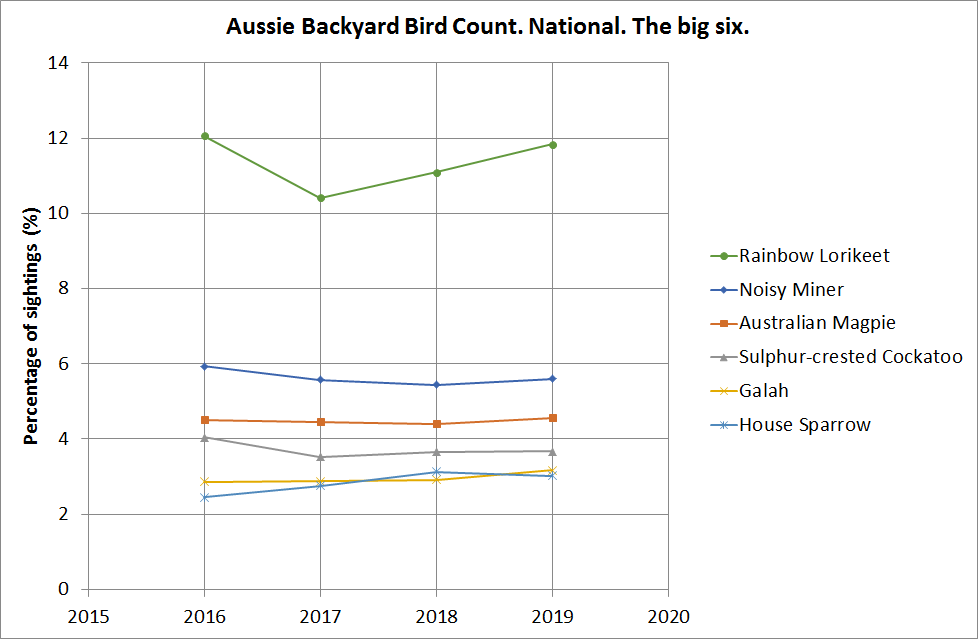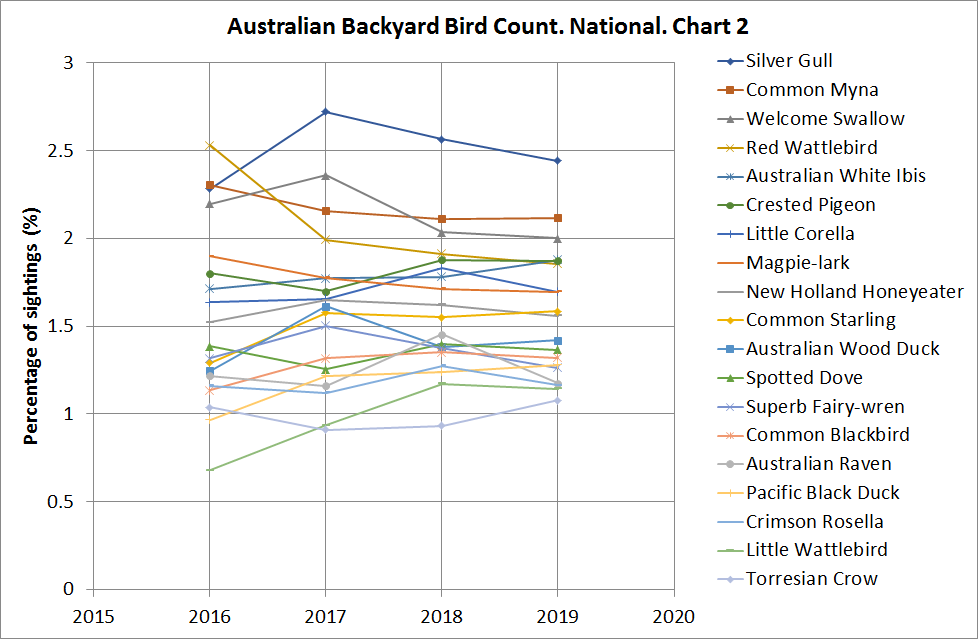Finally. They’ve posted the results from the 2019 October survey
https://aussiebirdcount.org.au/2019-results/
Download the 2019 species list for Australia and the states/territories here
Finally. They’ve posted the results from the 2019 October survey
https://aussiebirdcount.org.au/2019-results/
Download the 2019 species list for Australia and the states/territories here
mollwollfumble said:
Finally. They’ve posted the results from the 2019 October surveyhttps://aussiebirdcount.org.au/2019-results/
Download the 2019 species list for Australia and the states/territories here

mollwollfumble said:
Finally. They’ve posted the results from the 2019 October surveyhttps://aussiebirdcount.org.au/2019-results/
Download the 2019 species list for Australia and the states/territories here
Four years is the minimum necessary for even tentatively looking at trends. And the survey has now been going for four years. So lets look at the trends.
Absolute numbers are not useful because of the survey method, only relative numbers. Also, because of the survey method, numbers of rarely seen birds cannot be relied on for trends.
Hypothesis 1. Introduced birds are on the rise.
Hypothesis 2. Large birds are on the rise and small bird numbers falling.
These hypotheses need testing. But in the meantime, the biggest winner and loser over the 2016-2019 timespan turn out to be completely unexpected. The big loser is the Red Wattlebird. The big winner is the Little Wattlebird. LOL.
In 2016 there were 3.7 Red Wattlebirds for every Little Wattlebird
In 2019 there were 1.6 Red Wattlebirds for every Little Wattlebird


mollwollfumble said:
These hypotheses need testing. But in the meantime, the biggest winner and loser over the 2016-2019 timespan turn out to be completely unexpected. The big loser is the Red Wattlebird. The big winner is the Little Wattlebird. LOL.
In 2016 there were 3.7 Red Wattlebirds for every Little Wattlebird
In 2019 there were 1.6 Red Wattlebirds for every Little Wattlebird
Another really big winner, just as unexpected, is Straw-necked Ibis. It has more than tripled its numbers since 2016.
From 0.31% of sightings in 2016 to 0.97% of sightings nationally in 2019.
Another really big loser, but only in 2019, is Magpie Goose.
0.80% of sightings in 2016
0.84% of sightings in 2017
1.06% of sightings in 2018
0.26% of sightings in 2019
What’s happening here? Migration or death?
> As the species is prone to wandering, especially when not breeding. …
There was one in Melbourne for many years, just one, in the exact same spot each year, not moving more than 10 metres from year to year.
> The species was once also widespread in southern Australia, but disappeared from there …
Hmm. Let’s hope it’s not also disappearing from northern Australia.
>>In 2016 there were 3.7 Red Wattlebirds for every Little Wattlebird
In 2019 there were 1.6 Red Wattlebirds for every Little Wattlebird<<
Err that tells us nothing.
P_P is probably ensconced in front of the TV with a rum and coke watching the cricket now.
Have I died and gone to heaven??
KYLIE MINOGUE’S SECRET NIGHT SBS 7:30 pm – 8:30 pm | Today
https://www.ontvtonight.com/au/guide/listings/programme?cid=2346&sid=769392&dt=2020-02-08+08%3A30%3A00”:https://www.ontvtonight.com/au/guide/listings/programme?cid=2346&sid=769392&dt=2020-02-08+08%3A30%3A00
Woodie said:
Have I died and gone to heaven??KYLIE MINOGUE’S SECRET NIGHT SBS 7:30 pm – 8:30 pm | Today
https://www.ontvtonight.com/au/guide/listings/programme?cid=2346&sid=769392&dt=2020-02-08+08%3A30%3A00”:https://www.ontvtonight.com/au/guide/listings/programme?cid=2346&sid=769392&dt=2020-02-08+08%3A30%3A00
What’s the secret?